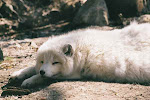Hi!
Today I'm talking about arctic foxes. I've always liked the arctic fox, I just really didn't know about it. I think arctic foxes are really cute, and one of my favorite animals. I hope you like these facts about the arctic fox.
What does an arctic fox eat?
The arctic fox eats mainly small mammals, including tundra voles, lemmings, arctic hare, carrion, fish, and eggs. If an arctic fox lives near the seacoast, it depends on seabirds like puffins, murres, and auklets. Sometimes they eat ringed seal pups in the spring. Arctic foxes store the food they didn't eat. If they can't find their usual prey, they will steal some scraps from a larger animal, like the polar bear, and they'll eat seaweed, berries, insects, and larvae. They also eat mice, molting and nesting birds, and flightless young.
Where does an arctic fox live?
The arctic fox lives in Greenland, Russia, northern and western Alaska, northern Canada, south and northern Northwest Territories, northern Quebec, northeast Alberta, and northern Manitoba. They also live in Norway, Sweden, Finland, and Svalbard. They also live in alpine and subarctic places like Iceland.
What eats the arctic fox?
Polar bears and wolves are the main predators of the arctic fox. Golden eagles and bears are predators to arctic fox young, because they can dig the young out of the den, while their mother is out hunting.
How does an arctic fox take care of its young?
Arctic foxes mate from February to May. Arctic foxes can mate when they're one year old. Female arctic foxes are pregnant for 52 days; that's 7 and a 1/2 weeks. Litters average from 5 to 8 pups, but there has been reports of up to 25 pups. Pups are born blind and helpless, weighing only 2 ounces. Both parents care for the young pups. The mother nurses her young for 6 weeks. After 6 weeks, the pups start to eat solid food. As the mother teaches her young, the father hunts. After 14 to 15 weeks, the pups take their first steps out of their den. The pups stay with their parents from summer to fall.
Characteristics of the arctic fox:
The arctic fox lives for 3 to 4 years in the wild. It can live up to 14 years in captivity. It has the warmest fur of any mammal, and is endangered worldwide. The arctic fox has white fur in the winter, and it can have two-tone brown in the summer or bluish-gray fur in the summer. Its nicknames are polar fox and white fox.
I hope you liked the facts about the arctic fox.
Until next time,
Chiara
(P.S. here are the sites I got my information from: check them out!)
*Footnotes*
http://library.thinkquest.org/3500/arctic_fox.htm
http://en.wikipedia.org/wiki/Arctic_Fox
http://www.blueplanetbiomes.org/arctic_fox.htm
http://www.env.gov.nl.ca/snp/Animals/arctic_fox.htm
I really like the blue planet biomes website. Check it out:
http://www.blueplanetbiomes.org/world_biomes.htm
Hope you like the sites!
Go Green
Welcome to Go Green Girl! I hope you like all the pictures and gadgets and lists I have on my blog. Enjoy reading my posts!
Chiara
Chiara
Wednesday, March 31, 2010
Subscribe to:
Post Comments (Atom)
The Green News
Hi! Welcome to the Green News! Every two weeks, check this section for new news. Today's headlines are:
Save The Saker!
Saker falcons are an endangered species.
The Saker falcon's preferred prey became extinct, and now, Saker falcon numbers are declining.
People are trying to save this bird, and its habitat, which is getting destroyed by people farming, and digging for oil.
To learn more about the Saker falcon, go to the post 'The Saker Falcon'.
Go Greener (a.k.a. Chiara).
Save The Saker!
Saker falcons are an endangered species.
The Saker falcon's preferred prey became extinct, and now, Saker falcon numbers are declining.
People are trying to save this bird, and its habitat, which is getting destroyed by people farming, and digging for oil.
To learn more about the Saker falcon, go to the post 'The Saker Falcon'.
Go Greener (a.k.a. Chiara).



.jpg)






No comments:
Post a Comment